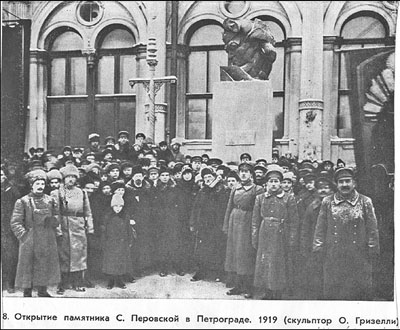A historical puzzle? OK, a monument dedicated to Sofia Perovskaia (Софья Львовна Перовская, 1853-1881) clearly existed in Bolshevik Russia, but there is some question to its location and to how long it lasted.
The image on the page (Revolutionary Movement remarks by Professor Blois) is a photo of a Perovskaia monument, which Professor Otto Karl Werckmeister has identified as "Photograph of Vladimir Tatlin (1885-1953) dedicating the monument to Sofia Perovskaya, 20 December 1918, USSR." (accessed at http://faculty-web.at.northwestern.edu/art-history/werckmeister/April_20_1999/MonProp.jpg)
But according to Anna Eremeeva and Dan Healey, "Woman and Violence in Artistic Discourse of the Russian Revolution and Civil War (1917–1922)," Gender & History, 16 (3), (2004): 726-743: "A monument unveiled in Moscow on the first anniversary of the Bolshevik seizure of power, sculpted by Ivan Rakhmanov, was considered artistically weak and was soon removed. A second Perovskaia monument by the Italian Futurist Orlando Grizelli was unveiled in December 1918 in Petrograd (Figure 4). The large head on a quadrilateral plinth reminded some of a lioness and others of a bat. It too was soon removed." So which monument is depicted? (Note the date problem in this quotation.)
Now the Eremeeva and Healey article includes this image, which, if you look closely, is the same image that we started with:

The caption of the photo clearly reads, "Opening of the monument to S. Perovskaia in Petrograd 1919 (sculptor O. Grizelli)." The footnote credits this image to Vladimir Tolstoi, U istokov sovetskogo izobrazitel'nogo iskusstva (Moscow: Izobrazitel'noe iskusstvo, 1983), p. 99 or p. 219 (There is some contradiction about the correct page number).
Can anyone figure out the real details surrounding the Perovskaia monument pictured in these images?